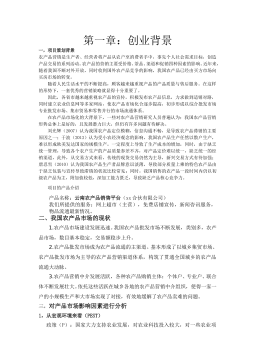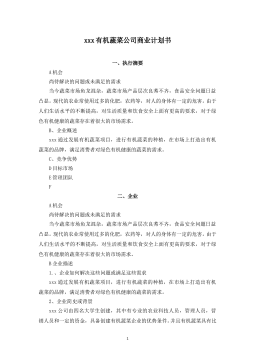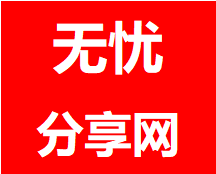热分层环境下红外光束感烟探测器探测报警时间研究
VIP免费
VI
摘 要
大空间建筑往往存在着危险等级高、火灾水平蔓延速度快的特点,一旦发生
火灾极易造成群死群伤和大面积火灾。由于大空间建筑通常具有一定的高度,受
太阳辐射、室内热源及建筑底部空调系统的影响,室内环境往往在垂直方向上存
在着较大的温度梯度,温度分层现象显著。火灾时烟气羽流受浮力作用上升的现
象受温度分层影响而减弱,严重时环境产生的热障效应将导致烟气无法上升,从
而延缓了探测烟气的时间。为了实现对大空间建筑火灾的快速探测,尽可能减少
人员和财产损失,对热分层环境下烟气羽流上升特性及探测报警时间的相关研究
就显得尤为重要。
论文针对大空间 15m×15m×30m 的物理模型,就火源释热率在 100~
1000kW、基准环境温度为 13~28℃、温度梯度分别为 0℃/m、0.5℃/m、1.0℃/m
的120 个工况进行了烟气上升运动模拟计算,分析了火源释热率,基准环境温度
及温度梯度对烟气羽流上升的影响。结果表明,烟气羽流上升时间与火源释热率
呈负相关,与基准环境温度及温度梯度呈正相关。三个影响因素中火源释热率对
上升时间的影响最大,温度梯度次之,基准环境温度最小。分析温度分层对烟气
羽流影响的结果表明,火源释热率为 500kW 及以上的烟气羽流均能抵达屋顶,而
火源释热率为 200kW 及以下的烟气羽流因受热障效应影响较大,当环境梯度为
1.0℃/m 时不能到达屋顶。
论文通过对模拟计算结果的分析,就火源释热率为 300kW和400kW的各工况,
对不同热分层环境和不同基准环境温度下红外光束感烟探测器的探测报警时间进
行了分析。探测报警时间由羽流上升时间 tz和烟气浓度增大至探测器报警阈值的
时间 t’两部分组成。分析结果表明当火源释热率较大时,tz占探测时间的比重较大,
此时分层环境对探测时间的影响非常微小;当火源释热率较小时,t’占探测时间的
比重较大,此时温度梯度较大的分层环境能够显著减少探测时间。此外论文根据
模拟结果还分析确定了红外光束感烟探测器在大空间建筑中的最佳布设方式:在
垂直方向上,当大空间建筑高度低于 9m 时,可单层设置;当高度为 10~14m 时,
可双层设置;当高度为 15~30m 时,可三层设置。在水平方向上,可根据安装间距
不得大于该高度处烟气羽流直径的原则来确定。
通过对热分层环境下烟气羽流最大上升高度公式的修正及轴心温度计算公式
的推导,应用伯努利方程与数值模拟结果,通过分析羽流上升时间分段发展的特
点,建立了稳定线性热分层环境下轴对称烟气羽流上升时间分两段的求解数学模
VII
型tz=f(z),计算结果表明所建模型能够很好地反映热分层环境下烟气羽流的上升特
性。计算基准环境温度为 13℃,环境梯度为 0.5℃/m 和1.0℃/m 的12 个工况结果
表明,4m 至分段转折点高度区间内,羽流上升所需时间的模型计算值和模拟值的
标准差均在 0.6s 以内,标准差平均值为 0.42s;在 4m 至屋顶或羽流最大上升高度
的区间内,模型计算值和模拟值的标准差也大部分在 1s 以内,标准差平均值为
0.66s。最后,文章提出了烟气浓度上升至报警阈值所需时间 t’的计算方案及理论求
解思路。
本文对烟气羽流上升特性及红外光束感烟探测器探测报警时间的相关研究可
为消防性能化设计及相关规范和标准的制定提供一定参考。
关键词:烟气羽流 大空间建筑 热分层环境 红外光束感烟探测器 上
升时间 探测报警时间
VIII
ABSTRACT
There are always high level of fire risk category and high rate of fire spread in large
space buildings, which may result in heavy casualties in case of fire. Large space
buildings usually have certain height above the floor. So affected by solar radiation,
indoor heat source and HVAC system, big vertical temperature gradient will form in the
indoor environment of large space buildings. The rising of smoke plumes is driven by
buoyancy force due to the difference in temperature between smoke plumes and
ambient enviroment. Therefore, in thermally stratified environments, the difference in
temperature will decrease with height, which will delay or even block up the rising
process of smoke plumes. Once the so called heat barrier effect is produced, the
detection time of smoke plumes will increase. In order to fulfill the rapid detection to
large space building fires and largely avoid casualties and property losses, it is quite
necessary to do related research on rising characteristic of smoke plumes and detection
time in thermally stratified environments.
A building model that measures 15 by 15 by 30 is built to simulate and analyze the
infulence from fire heat release rate, reference temperature and temperature gradient on
the rising process of smoke plumes when fire heat release rate is 100~1000kW,
reference temperature is 13~28℃ and temperature gradient is 0~1℃/m . The 120
numerical simulation and analyzed results demonstrate that the rising time of smoke
plumes has a positive correlation with fire heat release rate and has a negative
correlation with reference temperature and temperature gradient. Besides, fire heat
release rate affects the rising time most, the temperature gradient does less, and the
reference temperature does the least. The analysis results of the influence from
thermally stratified environment on smoke plumes show that when fire heat release rate
is greater than or equal to 500kW, smoke plumes can easily reach the ceiling. But when
fire heat release rate is less than or equal to 200kW, smoke plumes are notably affected
by heat barrier effect and can’t reach the ceiling when temperature gradient is 1℃/m.
According to the simulation and calculation results, the cases whose fire heat
release rate is 300kW or 400kW are chosen to analyze the the detection time of infrared
beam smoke detector. The detection time consists of the rising time tz and the time t’
IX
during which the smoke concentration rises up to alarm threshold. The analysis results
indicate that when fire heat release rate is large, tz is in a larger proportion of detection
time. In that case thermally stratified environments have little effect on detection time.
But when fire heat release rate is small, t’ is in a larger proportion of detection time. In
this instance, the detection time can be remarkably reduced by the great temperature
gradient. In addition, according to the analysis on the detection time of infrared beam
smoke detector under different fire heat release rates and thermally stratified
environments, the optimal form and location of infrared beam smoke detector in large
space buildings is determined. When building height is below 9 meters, the detectors
can be set within a single level. When building height is 10~14 meters, the detectors can
be set at two levels. When building height is 15~30 meters, the detectors can be set at
three levels. The spacing between beams is based on the narrowest potential width of
the plume at the level of detection.
Meanwhile, through modifying the calculating formula of maximum rise of fire
smoke plumes and formula derivation of centreline plume temperature, a piecewise
mathematical model tz=f(z) is presented to calculate the rising time of axisymmetric
plume fronts in stably linearly thermally stratified environments by applying Bernoulli
equation and numerical simulation. The rising characteristic of smoke plumes in in
thermally stratified environments can be well represented by the mathematical model.
When reference temperature is 13℃ and temperature gradient is 0.5℃/m and 1.0℃/m
respectively, the simulation results show that the standard deviations between
theoretical results and simulated results of 12 fire cases are below 0.6 second in the
segment of 4~ zsep and are mostly below 1 second in the segment of 4~29(or 4~
m
z
). The
average of standard deviations are 0.42 second and 0.66 second respectively in above
two segments. At last, a scheme to calculate the during time when smoke concentration
rises up to alarm threshold is introduced.
In the paper, the related research of rising characteristic of smoke plumes and
detection time of infrared beam smoke detector is useful to performance-based fire
design and will offer reference to making out correlative criterions and standards.
Key words: Smoke plume, Large space buildings, Thermally stratified
environments, Infrared beam smoke detector, Rising time,
Detection time.
X
目 录
中文摘要
ABSTRACT
第一章 绪论 .......................................................... 1
§1.1 研究背景及意义 ............................................ 1
§1.2 烟羽流特性及探测器探测时间研究现状 ........................ 2
§1.2.1 热分层环境下烟羽流特性研究现状 ...................... 2
§1.2.2 烟羽流上升时间及探测时间研究现状 .................... 3
§1.2.3 火灾 CFD 模拟技术发展现状 ............................ 4
§1.3 课题研究基本思路及其主要研究内容 ........................... 6
§1.3.1 课题研究的基本思路 .................................. 6
§1.3.2 主要研究内容 ........................................ 6
第二章 火灾探测器选用与布局的分析 .................................... 8
§2.1 火灾发展过程与人员安全疏散分析 ............................ 8
§2.1.1 建筑火灾发展过程 .................................... 8
§2.1.2 火源及其释热率 ...................................... 9
§2.1.3 人员安全疏散分析 ................................... 11
§2.2 火灾探测器的选用及布局的思考 ............................. 12
§2.2.1 常用的火灾探测器及选用原则 ......................... 12
§2.2.2 红外光束感烟探测器安装位置设置存在的问题 ........... 15
§2.2.3 设置红外光束感烟探测器安装位置的思考 ............... 17
§2.3 本章小结 ................................................. 18
第三章 红外光束感烟探测器探测时间数值模拟研究 ....................... 19
§3.1 模拟案例设定 ............................................. 19
§3.1.1 FDS 软件介绍 ........................................ 19
§3.1.2 羽流形态及其分类 ................................... 20
§3.1.3 模型建立与测点布置 ................................. 21
§3.1.4 火源设置及网格划分 ................................. 22
§3.1.5 火灾场景设置 ....................................... 24
§3.2 烟羽流环境模拟结果分析 ................................... 25
§3.2.1 分层环境作用下烟羽流温度场及速度场分析 ............. 25
§3.2.2 羽流上升影响因素分析 ............................... 30
XI
§3.2.3 探测报警时间分析 ................................... 40
§3.2.4 探测器最佳布置方案 ................................. 44
§3.3 本章小结 ................................................. 46
第四章 红外光束感烟探测器探测报警时间理论分析 .......................47
§4.1 均匀环境下烟气羽流上升时间理论分析 ....................... 48
§4.2 稳定线性热分层环境下烟气羽流上升时间分段求解模型 ......... 50
§4.2.1 烟气羽流最大上升高度和中性浮力点高度 ............... 50
§4.2.2 环境温度及烟气羽流轴心温度 ......................... 51
§4.2.3 上升时间分段求解模型建立 ........................... 53
§4.3 烟气浓度增大至报警阈值所需时间的分析 ..................... 62
§4.4 本章小结 ................................................. 64
第五章 结论及展望 ...................................................65
§5.1 结论 ..................................................... 65
§5.2 展望 ..................................................... 66
参考文献 ............................................................67
第一章 绪论
1
第一章 绪论
§1.1 研究背景及意义
近年来我国发生的多起重大、特大火灾,许多都是发生于大空间建筑。如洛
阳东都商厦特大火灾、克拉玛依友谊馆火灾以及吉林市中百商厦火灾等,造成了
重大的人员伤亡和财产损失。通常空间高度大于 5m,体积大于 1万m3的建筑被
称为大空间[1]。一般大型商场、剧院、音乐厅、会展中心、体育馆、展览馆等都是
以大空间建筑的形式建成。随着社会经济的发展,大空间的使用功能和特性变得
日益复杂和灵活多变,从而导致火灾发生时人员及货物的安全疏散变得愈发困难。
由于大空间建筑往往存在着危险等级高、火灾水平蔓延速度快的特点,火灾发生
所带来的危害和严重后果,与以往小型、低层、单一化建筑无法相比,极易造成
群死群伤和大面积火灾。长期以来,火灾发生后采用的防排烟系统一直是设计人
员最关注的问题之一,其中防排烟系统启动时间的研究就显得尤为重要。
据相关统计,发生火灾时烟气危害是导致人员伤亡的主要原因之一,死亡人
数中有 50%左右是因烟气窒息或中毒而死[2]。由于大空间建筑内部存在很大的无隔
断的空间,难以设置防火防烟分隔设施,致使高温烟气难以排出,很容易迅速蔓
延到建筑(如中庭)的其它部分,对人员造成更大的危害。保证建筑物内人员安
全疏散的关键是,所有人员疏散完毕所需的时间 RSET (Required Safety Egress Time)
必须小于火灾发展到危险状态的时间 ASET (Available Safety Egress Time)。RSET
由探测报警时间、人员疏散预动作时间和人员运动这三部分构成。目前一切性能
化防火设计以及探测设备的研发都是为了尽可能的缩短 RSET,延长 ASET。因此
在火势对人员和财产造成巨大危害之前,尽早探测到上升的烟气并发出警报具有
极其重要的意义,这可为在场人员的安全疏散和逃生提供更多的时间,同时可以
及时启动相应的消防措施将火灾遏制在初期阶段,减少相关损失。
对于大空间建筑,由于通常具有一定的高度,这使得处于阴燃状态或火灾初
期规模较小的火灾烟雾在上升过程中不断被卷吸进来的冷空气所稀释,浓度不断
减小。尤其对于那些高度较高且顶棚采用玻璃采光的中庭,受太阳辐射和建筑底
部空调系统的影响,使得大空间室内环境往往在垂直方向上存在着较大的温度梯
度。在夏季高温时这种温度分层现象更加严重,高大空间顶部通常会形成一定厚
度的热空气层。由于烟气上升的驱动力是由烟气温度和环境温度之间的温差引起
的浮力所驱动,而在温度分层环境下这种温差随着高度越来越小,从而在火灾发
热分层环境下红外光束感烟探测器探测报警时间研究
2
生时延缓了烟气上升的进度,严重时甚至导致烟气上升至顶棚之前就完全失去了
上升的动力,在某一高度处形成了蘑菇团而难以继续上升,即产生所谓的热障效
应。因而对于大空间火灾的早期探测,并不适宜采用点型感温探测器。因为火灾
烟气在上升过程中卷吸大量冷空气,致使烟气温升并不是很高,甚至达不到感温
探测器所需的报警阈值。同样,由于温度分层现象导致火灾产生的烟雾很难到达
空间顶部,因而大空间建筑中也不适宜安装点型感烟探测器进行火灾监测和报警。
而对于在大空间建筑中得到广泛应用的红外光束感烟探测器,其探测原理是根据
发射器与接收器之间的红外光束强度是否由于烟气的遮挡而低于设定阈值来决定
是否报警的,因而在热分层环境下由于烟气上升受阻红外光束感烟探测器也存在
对于高度较高(大于 20m)的大空间是否适用,以及应如何布设的问题。因此对温
度分层环境下烟气羽流的上升特性以及红外光束感烟探测器探测报警时间的研究
是很有意义的,可为大空间建筑火灾风险评估及人员疏散等相关研究提供参考。
本文将采用数值模拟分析和建立数学模型分析两种方法研究大空间温度分层环境
下烟气上升规律以及红外光束感烟探测器探测报警时间。
§1.2 烟羽流特性及探测器探测时间研究现状
§1.2.1 热分层环境下烟羽流特性研究现状
关于分层环境下浮力羽流特性的研究大多集中在液相流体密度分层环境下的
发展规律研究,例如水环境的密度分层多由于温度分布或盐度分布不均匀所引起,
其研究对象前者如水库或深水湖泊,后者如河口、港湾和近海[3]。这类相关研究主
要针对污水(或污染物)在垂直方向上分层的水体的运动机理进行分析,或者
是研究热分层环境下船模尾流温度分布与扩展的规律[4]。而火灾烟气热物性参
数与单纯液相流体有很大的不同,火灾烟气羽流大多为湍浮力热烟气羽流,而
通常采用的盐水试验中盐水在清水中的运动是重力驱动的流动,即反浮力驱动
流[5]。目前国内外学者对烟羽流在分层环境中的上升特性已有了初步的研究,
但是还有许多需要完善和深入的地方。
Morton由水力学实验得出了线性热分层环境下火灾烟气羽流的最大上升高
度公式[6]。Heskestad通过实验建立了温度分层的环境,对该条件下火羽流是否
能够上升至顶棚进行了分析,并对相关联的羽流温升分布和CO2浓度分布进行
了研究[7],得出了无量纲羽流轴心温升,无量纲羽流上升速度,以及无量纲羽
流宽度随无量纲羽流最大上升高度之间的关系曲线[8]。国内学者中胡浩针对某
相关推荐
-
【拔高测试】沪教版数学五年级下册期末总复习(含答案)VIP免费
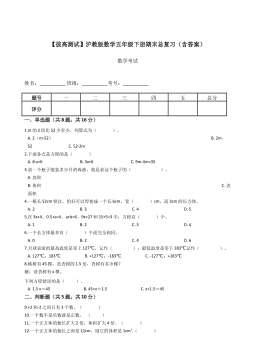
 2024-11-19 19
2024-11-19 19 -
【基础卷】小学数学五年级下册期末小升初试卷四(沪教版,含答案)VIP免费
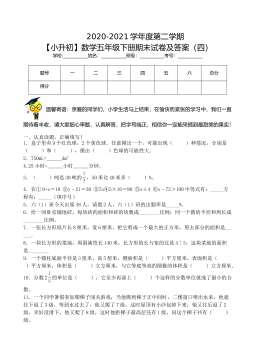
 2024-11-19 9
2024-11-19 9 -
期中测试B卷(试题)-2021-2022学年数学五年级上册沪教版(含答案)VIP免费
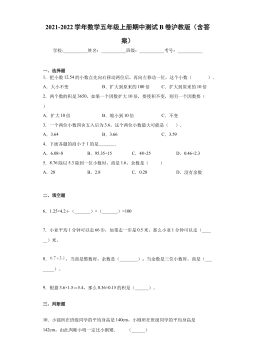
 2024-11-19 11
2024-11-19 11 -
期中测试B卷(试题)- 2021-2022学年数学五年级上册 沪教版(含答案)VIP免费
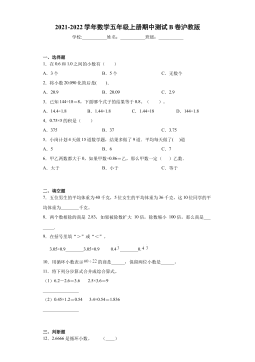
 2024-11-19 16
2024-11-19 16 -
期中测试A卷(试题)-2021-2022学年数学五年级上册沪教版(含答案)VIP免费
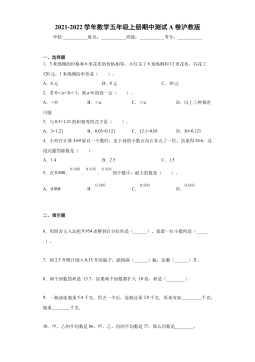
 2024-11-19 18
2024-11-19 18 -
期中测试A卷(试题)-2021-2022学年数学五年级上册 沪教版(含答案)VIP免费
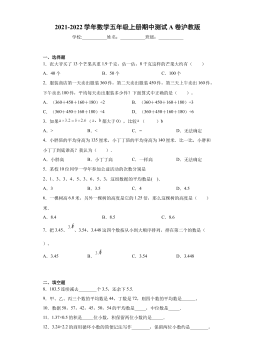
 2024-11-19 25
2024-11-19 25 -
期中测B试卷(试题)-2021-2022学年数学五年级上册 沪教版(含答案)VIP免费
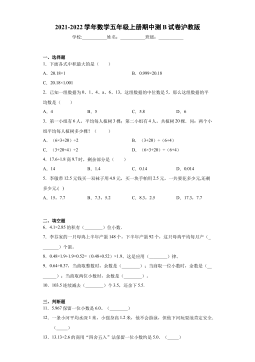
 2024-11-19 23
2024-11-19 23 -
期中测A试卷(试题)-2021-2022学年数学五年级上册沪教版(含答案)VIP免费

 2024-11-19 31
2024-11-19 31 -
【七大类型简便计算狂刷题】四下数学+答案
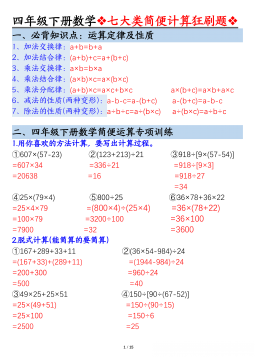
 2025-03-18 16
2025-03-18 16 -
【课内金句仿写每日一练】四下语文
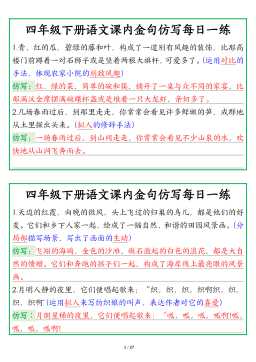
 2025-03-18 39
2025-03-18 39
作者:高德中
分类:高等教育资料
价格:15积分
属性:76 页
大小:3.32MB
格式:PDF
时间:2025-01-09
相关内容
-

期中测试A卷(试题)-2021-2022学年数学五年级上册 沪教版(含答案)
分类:中小学教育资料
时间:2024-11-19
标签:无
格式:DOCX
价格:5 积分
-

期中测B试卷(试题)-2021-2022学年数学五年级上册 沪教版(含答案)
分类:中小学教育资料
时间:2024-11-19
标签:无
格式:DOCX
价格:5 积分
-

期中测A试卷(试题)-2021-2022学年数学五年级上册沪教版(含答案)
分类:中小学教育资料
时间:2024-11-19
标签:无
格式:DOCX
价格:5 积分
-

【七大类型简便计算狂刷题】四下数学+答案
分类:中小学教育资料
时间:2025-03-18
标签:数学计算;校内数学
格式:PDF
价格:1 积分
-

【课内金句仿写每日一练】四下语文
分类:中小学教育资料
时间:2025-03-18
标签:无
格式:PDF
价格:1 积分


